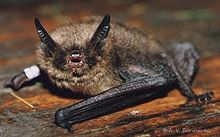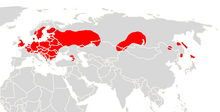Brandt's bat
| Brandt's bat | |
|---|---|

| |
| Scientific classification | |
| Kingdom: | Animalia |
| Phylum: | Chordata |
| Class: | Mammalia |
| Order: | Chiroptera |
| Family: | Vespertilionidae |
| Genus: | Myotis |
| Species: | M. brandtii
|
| Binomial name | |
| Myotis brandtii (Eversmann, 1845)
| |

| |
| Synonyms | |
| |
Brandt's bat (Myotis brandtii) is a species of vesper bat in the family Vespertilionidae. It is native throughout most of Europe and parts of Asia.[1] It is known for its high life expectancy relative to its body size, approximately twice that of humans and holds the record for the oldest bat; in 2005, one individual was discovered in a cave in Siberia that had been banded in 1964, making the bat at least 41 years old.[2]
Taxonomy and etymology[]
The species was described in 1845 by German zoologist Eduard Friedrich Eversmann, who placed it the genus Vespertilio.[3] For a time, the Brandt's bat was considered a subspecies of the whiskered bat, Myotis mystacinus. In 1958, one author proposed that the two might be separate species, based on baculum differences; this idea gained traction in papers authored in 1970 and 1971.[4] It is named for the German zoologist Johann Friedrich von Brandt.[5]
Description[]
It is a small bat, with the length of its head and body only 39–51 mm (1.5–2.0 in). Its forearm is 33–39 mm (1.3–1.5 in) long; its tail is 32–44 mm (1.3–1.7 in) long; its hind feet are 7–9 mm (0.28–0.35 in) long; its ears are 12–17 mm (0.47–0.67 in). It has long fur relative to its body size. The fur on its back is pale brown with a golden sheen, while the fur on its ventral side is paler gray, sometimes with a yellowish tinge. Its tragus is narrow and pointed.[6]
Biology[]

Like primates and other bats, the Brandt's bat has lost the ability to synthesize vitamin C.[7] Individuals in Siberia have exceptionally long hibernation periods, beginning in late September and continuing through mid-June of the following year.[8] During the winter, Brandt's bat will roost in mine shafts, caves, tunnels, and cellars. Some–but not all– populations hibernate in the winter, while others are partially migratory. They are insectivorous, foraging at low altitudes through quick, maneuverable flight.[6]
Reproduction[]
During the summer, females will form maternity colonies to raise their young. The litter size is one pup, though occasionally two are born. Pups are born in early summer, with pups becoming volant around one month of age. Maternity colonies are frequently in manmade structures.[6] Maternity colonies have also been found in tree cavities and in bat houses. Some females reach sexual maturity at three months of age, but most do not breed until after reaching a year of age.[9] Mating occurs in the fall,[9] but females store the sperm until the spring, which is when fertilization occurs.[7]
Longevity[]
In the early 1960s, 1,544 Brandt's bats were banded in Siberia. Of these individuals, at least 67 lived longer than 20 years (of note, all of these individuals were male).[8] In 2001, two individuals were documented 38 years after capture, making them, at the time, the longest-lived individuals of this species ever recorded.[10] However, three years later, one of these individuals was documented again. This meant that the longest-lived individual of this species was at least 41 years old.[8]
Not all populations of Brant's bat have such life expectancies. Populations near Saint Petersburg live approximately 8.5 years; populations in the Baltic region do not live longer than 18.5 years.[8] In mammals, larger animals tend to have longer lifespans than smaller ones; the Brandt's bat is the most extreme outlier to this pattern, with lifespans exceeding 40 years in the wild while only weighing 4–8 g (0.14–0.28 oz).[7] Compared with other animals its size, it lives 9.8 times longer than expected, which is the greatest value of any mammal with a known lifespan.[8] Researchers identified changes in its growth hormone receptors and insulin-like growth factor 1 receptors that likely contribute to its long life expectancy. By roosting in caves, it is able to avoid extreme weather conditions and predators, increasing its chances of living a long life. It also hibernates, which is linked to longer life expectancies in bats.[7]
Senses[]
Like other echolocating bats that use echolocation to detect prey instead of other senses, it has a reduction in the number of genes responsible for the sense of smell. Its eyes are small and adapted to vision in low-light levels. They are likely totally or partially color-blind, and likely unable to see clearly in bright daylight.[7] The frequencies used by this bat species for echolocation lie between 32 and 103 kHz, have maximum energy density at 51 kHz and have an average duration of 4.2 ms.[11][12]
Range and habitat[]
It has a palearctic distribution, and can be found in the following regions: Great Britain, Western Europe, Central Europe, Fennoscandia, Russia, Central Asia, Mongolia, China, and Japan.[1] In the Balkans it is limited to the mountains.[13] Recently, Brandt's bat was documented in Ireland for the first time.[14] It has been documented at elevations from 0–1,800 m (0–5,906 ft) above sea level. It can be found in deciduous forests, or forests that are a mix of deciduous and coniferous trees. It is often found in close proximity to water.[1]
Conservation[]
It is currently evaluated as least concern by the IUCN. It meets the criteria for this designation because it is an abundant, widespread species, with no indication of a decline in its population.[1] Like all bat species in Europe, the Brandt's bat is a European Protected Species, meaning that it is illegal to deliberately capture, kill, injure, or disturb individuals; in addition, their roosts are protected as "breeding or resting" places.[15]
References[]
- ^ Jump up to: a b c d e Gazaryan, S.; Kruskop, S.V.; Godlevska, L. (2020). "Myotis brandtii (errata version published in 2021)". IUCN Red List of Threatened Species. 2020: e.T85566997A195857637. Retrieved 18 April 2021.
- ^ Locke, R. (2006). "The oldest bat". BATS Magazine. Vol. 24 no. 2.
- ^ Eversmann, E. F. (1845). Vespertiliones in promontoriis Uralensibus tractibusque confinibus observati. Moscow: Bulletin de la Société impériale des naturalistes de Moscou. pp. 18–21.
- ^ Rybář, P. (1976). "A craniometric comparison of Holocene populations of Myotis mystacinus (Kuhl, 1817) and M. brandtii (Eversmann, 1845)(Chiroptera, Mammalia)". Bijdragen tot de Dierkunde. 46 (1): 71–79. doi:10.1163/26660644-04601004.
- ^ Beolens, B.; Watkins, M.; Grayson, M. (2009). The eponym dictionary of mammals. JHU Press. p. 54. ISBN 978-0801895333.
- ^ Jump up to: a b c Hoffmann, R. S.; Lunde, D.; MacKinnon, J.; Wilson, D. E.; Wozencraft, W. C. (2010). Smith, A. T.; Xie, Y. (eds.). A guide to the mammals of China. Princeton University Press. p. 374. ISBN 978-1400834112.
- ^ Jump up to: a b c d e Seim, I.; Fang, X.; Xiong, Z.; Lobanov, A. V.; Huang, Z.; Ma, S.; Feng, Y.; Turanov, A.; Zhu, Y; Lenz, T.; Gerashchenko, M.; Fan, F.; Yim, S.; Yao, X; Jordan, D.; Xiong, Y.; Ma, M.; Lyapunov, A.; Chen, G.; Kulakova, O.I.; Sun, Y.; Lee, S.; Bronson, R.T.; Moskalev, A.A.; Sunyaev, S.R.; Zhang, G.; Krogh, A.; Wang, J.; Gladyshev, V.N. (2013). "Genome analysis reveals insights into physiology and longevity of the Brandt's bat Myotis brandtii". Nature Communications. 4: 2212. Bibcode:2013NatCo...4.2212S. doi:10.1038/ncomms3212. PMC 3753542. PMID 23962925.
- ^ Jump up to: a b c d e Podlutsky, A. J.; Khritankov, A. M.; Ovodov, N. D.; Austad, S. N. (2005). "A new field record for bat longevity". The Journals of Gerontology Series A: Biological Sciences and Medical Sciences. 60 (11): 1366–1368. doi:10.1093/gerona/60.11.1366. PMID 16339320.
- ^ Jump up to: a b "Brandt's bat" (PDF). bats.org. Bat Conservation Trust. 2010. Archived from the original (PDF) on November 15, 2017. Retrieved November 9, 2017.
- ^ Khritankov, A. M.; Ovodov, N. D. (2001). "Longevity of Brandt's bats (Myotis brandtii Eversmann) in central Siberia". Plecotus. 4: 20–24.
- ^ Parsons S, Jones G (2000). "Acoustic identification of twelve species of echolocating bat by discriminant function analysis and artificial neural networks" (PDF). J Exp Biol. 203 (Pt 17): 2641–2656. doi:10.1242/jeb.203.17.2641. PMID 10934005.
- ^ Obrist MK, Boesch R, Flückiger PF (2004). "Variability in echolocation call design of 26 Swiss bat species: Consequences, limits and options for automated field identification with a synergic pattern recognition approach". Mammalia. 68 (4): 307–32. doi:10.1515/mamm.2004.030. S2CID 86180828.
- ^ Myotis brandtii - Science for Nature Foundation
- ^ Boston, E. S.; Buckley, D. J.; Bekaert, M.; Gager, Y.; Lundy, M. G.; Scott, D. D.; Prodöhl, P.A.; Montgomery, W.I.; Marnell, F.; Teeling, E. C. (2010). "The status of the cryptic bat species, Myotis mystacinus and Myotis brandtii in Ireland". Acta Chiropterologica. 12 (2): 457–461. doi:10.3161/150811010x538025. S2CID 83910263.
- ^ "What are European Protected Species?". Biodiversity Planning Toolkit. Association of Local Government Ecologists (ALGE). 2011. Retrieved November 10, 2017.
External links[]
- ARkive Photographs
- Bats Magazine Archived 2014-08-09 at the Wayback Machine The oldest bats
- IUCN Red List least concern species
- Mouse-eared bats
- Bats of Europe
- Mammals of Russia
- Mammals of Central Asia
- Mammals of Turkey
- Taxa named by Eduard Friedrich Eversmann
- Mammals described in 1845
- Bats of Asia
